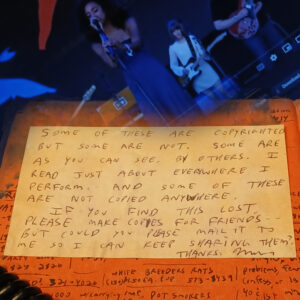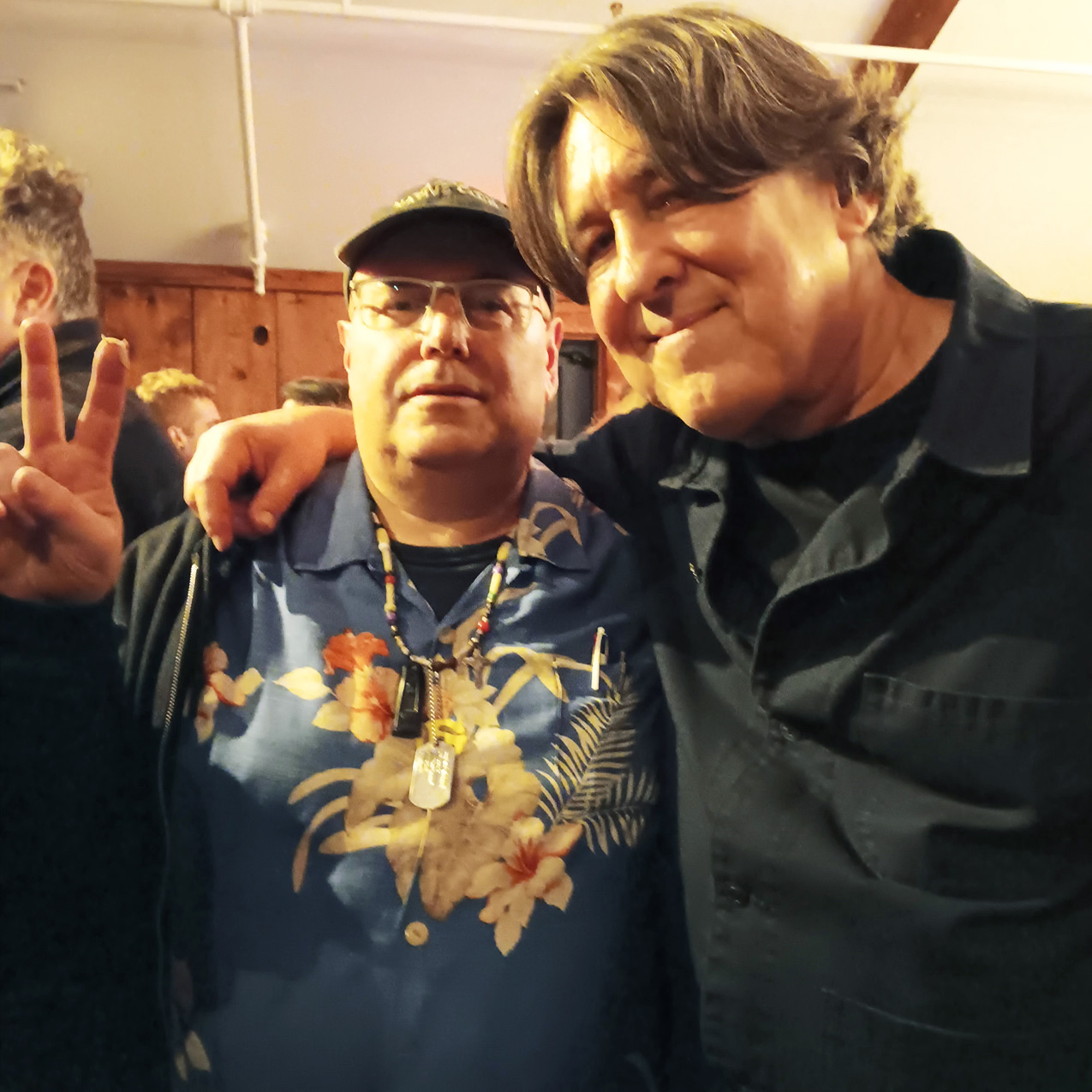1. I Hate a Song (Woody Guthrie) This speech featured many times at the Lake Superior Big Top Chautauqua voiced in by a guy who sounded just a bit like Studs Terkel. I’m told it was a speech Woody Guthrie gave somewhere, but it might’ve been something he published. Look around the Internet for provenance, the journey itself is worth twice the price.
2. Old Folk Singer (Merle Kessler) Ever heard of “Duck’s Breath Radio Theater”? They were a comedy troupe that began at the University of Iowa in the mid-1970’s but moved to San Francisco. Soon after, they released their first (self-released) album, “Out Of Season”, then moved to performing skits for National Public Radio’s “All Things Considered”. Eventually, they created and starred in “Dr. Science”, an offshoot of a popular “All Things Considered” skit, which was a parody of scientific TV shows. It was also one of the first shows on a new TV network called “Fox”.
Kessler, who performed under the stage name Ian Sholes in DBRT, and lab assistant Rodney on “Dr. Science”, wrote this as a parody of folk music in general, much in the same way Steve Goodman wrote “You Never Even Called Me by My Name” in the mid-1970’s.
3. How Come (You Do Me Like You Do) (Gene Austin – Roy Bergere) First recorded in 1924 by Marion Harris, this song, written by the vaudeville duo of Austin & Bergere, has become a jazz standard. Over the years, the song has been performed in various styles, such as New Orleans jazz (Kid Ory’s Creole Jazz Band and Louis Armstrong), straight pop (Teresa Brewer) and lounge (Julie London). Note: Speaking of London’s version, it was produced by her husband, Bobby Troup. Aside from Troup being the writer of “(Get Your Kicks On) Route 66”, both he and London became well-known outside of jazz circles through their starring roles on the TV series “Emergency!” as Dixie McCall, RN (London) and Dr. Joe Early (Troup).
4. Roll In My Sweet Baby’s Arms (Traditional; arranged by Frucht) This is a song about arms! Inspired by British sea shanties and Appalachian folk tales, Lester Flatt and Earl Scruggs released their version in 1951. Though not a “hit” at the time, it soon became a part of their live shows. Of course, it was often played in Folk circles in the early 1960’s. Oddly enough, Buck Owens had a major hit with it in 1971.
The “arms” in the song are the outstretched ones you race to when you come home or meet a loved one. That’s the only “arms race” worth participating in!
5. Completely Different Voiceover; Stacy Wilson
6. Gotham City 501 Blues (arranged by Frucht) Observations from the Summer of 1989. Also, a cautionary tale of not paying heed to laundry labels.
Picture this: Two of the biggest movies in the country are “Batman” and “Honey I Shrunk The Kids”. The Walkman, a personal cassette player, is the preferred means of taking music on the go. Lita Ford duets with Ozzy Osbourne on a song called “Close My Eyes Forever”. Barbie and Ken are, well… Barbie and Ken. After over a hundred years, Levi’s introduces their “501” line of jeans… for women. Neneh Cherry, fresh out of punk band Rip Rig & Panic, has an international hit with “Buffalo Stance” Take all this, blend it together with a bit of humor, and you have a song that captures the summer of ’89 quite well!
7. Mueslix: A Juicy Fruit Commercial Parody (parody lyrics: Frucht) In the late 1980’s, the W. K. Kellogg company introduced a new cereal to its lineup: a whole-grain and fruit cereal called “Mueslix”. The cereal, based on a traditional European whole-grain and fruit dish with the similar name “muesli”, was launched with a $33,000,000 advertising budget. Of course, you can make your own Muesli very easily and cheaply!
Around the same time, Wrigley had a promotion for its Juicy Fruit chewing gum, alongside the Doublemint twins and Spearmint’s “Pure Chewing Satisfaction” (long before it became the title for Lard’s second album). The “catchphrase” used for the commercial, “The taste is gonna move ya!” seems to fit Mueslix/muesli rather than fruit-flavored chewing gum. Here, Marco plays the jingle as it should have been written!
8. Hey Mon (Frucht – Franklin) You may have heard this song before. You probably didn’t know the name of it, but if you’ve ever dealt with MIDI files in any capacity, chances are, you’ve heard it.
Originally composed in the 1980’s, this tune is best known by its more common name, “REGGAE.MID”. I first heard this catchy little tune in the late 1980’s, while Marc and I were stationed at Fort Carson, CO.
Fast forward a couple of years, and “Hey Mon” becomes a part of the PC boom of the 1990’s, due to its inclusion in Creative Labs’ SoundBlaster 16 PCI/ISA sound cards, as part of the driver installation and MIDI demonstration package. The package proves to be a success, and millions of copies of “Hey Mon” are included in the package.
Only one problem, though. Nobody at Creative Labs sought to get permission from Marc to use his song!
9. Telephone Me, Baby (George M. Cohan) First published in 1899, this was among the first songs to celebrate the telephone’s use in romance. Even with the sometimes poor connections and (relatively) high costs of phone calls in those days, nothing stirred one’s soul like hearing your partner’s voice over the miles and miles of copper wire. The first verse of the song mentions mail and wire, meaning postal mail and telegrams. Both were replaced over the years by e-mail and text messaging, but there’s still nothing like a phone call from your loved one.
10. Is This Thing On? Voiceover by Staci Wilson
11. 1979 To the Tune of the Ancient Congregationalist Hymn “Were You There.”
12. Internet Killed the Video Star (music by Trevor Horn, Geoff Downes and Bruce Woolley; new lyrics by Frucht) As you may know, “Video Killed The Radio Star” was the first music video played on MTV in August 1981, although the song itself was issued two years earlier.
Unwittingly, MTV had opened a “Pandora’s Box” of issues in regard to its use of music videos and promotional films as the main source of its programming. Often, record companies would supply MTV with the videos (free of charge), but despite being shown nationally, few artists saw any reward for their efforts. On the other hand, if you were Michael Jackson or Madonna, you had the power to tell MTV how and when to play your video. But if you were Eye To Eye, Split Enz or Ebn-Ozn, you were lucky if your video got played at 2 AM, if they even played it at all. But, take heart, readers: The Free Design lambasted the MTV-originated ethos of style over substance in 2002 with “The Hook”
When .mp3 became a go-to format for listening to music, the recording industry tried to capitalize on it in the worst way possible: offering obscure music for several dollars per track. I doubt Andre Kostelanetz or Bert Jansch was on many people’s playlists, but that’s what the major labels offered. Unless, you went to the dark side… and used Napster.
As the PC became more and more a multimedia device, an application called RealAudio became one of the first media players to combine audio CD, *.mp3 and internet radio, all in one place. Those who have never heard streaming audio through RealPlayer, consider yourselves lucky. In the late ‘90’s and early 2000’s, dial-up internet was still used widely, and attempting to stream live content over a dialup connection was an exercise in frustration. As internet speeds became more robust, so did the quality of streaming audio and video.
Unfortunately, things haven’t changed much over the past 40 years. With the founding of YouTube, videos by major stars sit beside those by new artists. But getting compensated properly remains a challenge. And with audio-only subscription services such as Spotify, Tidal or even Apple Music, the majority of artists are paid in hundredths of a penny per stream. Not a good ecosystem to foster creativity!
13. Burma-Shave (Frucht) Before Dollar Shave Club and Harry’s were even thought of… there was Burma-Shave, one of the first “brushless” shaving lotions. Before, one had to put hot water in a mug containing a cake of shaving soap at the bottom. Using a shaving brush, one stirred the water/soap mixture until the lather was the desired consistency. Burma-Shave, on the other hand, was ready to use, right out of the jar.
In pre-World War II America, the majority of paved highways connecting towns and cities were two lanes. As functional as they were, a major trip would still take several days if not longer. Speed limits of 40 to 50 miles per hour in open country were common, and lower speed limits were in place in more populated areas.
One of the most famous pre-war highways was US Highway 66, or simply “Route 66”. If you drove on Route 66 or any other major road in that time, one could reasonably expect to come across a sequential series of five or six small signs, the first four or five containing one line of a poem, the last sign being the name of the product. Here’s an example:
Shaving brushes / You’ll soon see ’em / On the shelf / In some / Museum / Burma-Shave
The signs certainly propelled the Burma-Shave lotion to major popularity, and became part of the landscape of rural America. Unfortunately, with the rise of the Interstate Highway System, the signs soon disappeared from America’s roadways. And Burma-Shave itself began disappearing from store shelves as well.
Burma-Shave itself may be gone, but the signs continue to live on in American folklore. Roger Miller and Tom Waits paid tribute to the signs in song as well.
14. I Saw Elvis (to the tune of Groove is in the Heart by Deee-Lite) Considering that if the King were to avail himself to fast food, there is no shortage of options on Elvis Presley Boulevard in Memphis. Which ones may cause gastric turmoil remain to be seen!
15. Rumble (Acoustic Cover) (Link Wray) If there ever was an instrumental that rocked the world, this is it. But the story of how it got there is no less amazing. Fred Lincoln Wray, Jr. and his family had experienced discrimination due to their Shawnee Indian origins, living in profound poverty. After being in several local bands in Virginia, Wray served in the U. S. Army during the Korean War. During his enlistment, he had contracted tuberculosis, which saw him in the hospital for over a year and the loss of one lung. Link knew his days as an occasional vocalist were over, but after hearing Elvis Presley with Scotty Moore’s guitar, and a Creator-inspired vision, Link became a no-nonsense guitar player, refusing to be bound by convention. After his surgery and treatment for TB, his doctors had told him his performing days were over, Link told the doctors, “Well, there’s a mightier power than you that’s gonna tell me I can’t go out and play my music.” Archie Bleyer, head of Cadence Records (the label that released “Rumble”), had demanded Link recut the song at Cadence’s New York studios. Link told Bleyer, ‘Well, you either accept this, or you don’t get it at all–If you don’t want this one, f–k you. I’m not coming to New York.”
Regarded as the first single to use electronically-distorted guitar, Link’s “Rumble” influenced guitarists all over the world, from the British invasion of the 1960’s to today.
Some Songs produced entirely by Marco Frucht.
Others were Engineered by Carl Franklin and Produced by Neil Sheppard
Song list order organized by John Carta
Liner Notes in the Nat Hentoff tradition by Patrick Moore





